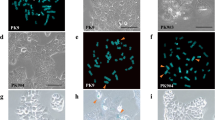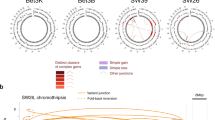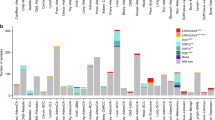Abstract
The introduction of a human chromosome 1 via microcell-mediated chromosome transfer (MMCT) induces the cellular senescence in mouse melanoma B16-F10 cells. The senescent cells maintained still the telomerase activity, which is frequently associated with immortal growth of human cells, suggesting that a telomerase-independent mechanism is involved in the senescence observed in this mouse cell line. To map the senescence-inducing gene to a specific chromosomal region, we took two experimental approaches: identification of a minimal region with the senescence-inducing activity via MMCT of a series of subchromosomal transferrable fragments (STFs), each consisting of a different profile of human chromosome 1-derived regions, and identification of a region commonly deleted from the transferred chromosome 1 in the revertant clones that escaped cellular senescence. These approaches identified a 2.7–3.0 Mb of senescence-inducing region shared among the active STFs and a 2.4–3.0 Mb of commonly deleted region in the revertant clones. These two regions overlapped each other to map the responsible gene at the 450 to 600-kb interval between UniSTS93710 and D1S3542 on chromosome 1q42.3. This study provides essential information and materials for cloning and characterization of a novel senescence-inducing gene that functions in a telomerase-independent pathway, which is likely to be conserved between mice and humans.
This is a preview of subscription content, access via your institution
Access options
Subscribe to this journal
Receive 50 print issues and online access
$259.00 per year
only $5.18 per issue
Buy this article
- Purchase on Springer Link
- Instant access to full article PDF
Prices may be subject to local taxes which are calculated during checkout







Similar content being viewed by others
References
Backsch C, Wagenbach N, Nonn M, Leistritz S, Stanbridge E, Schneider A and Durst M . (2001). Genes Chromosomes Cancer, 31, 196–198.
Berthon P, Valeri A, Cohen-Akenine A, Drelon E, Paiss T, Wohr G, Latil A, Millasseau P, Mellah I, Cohen N, Blanche H, Bellane-Chantelot C, Demenais F, Teillac P, Le Due A, de Petriconi R, Hautmann R, Chumakov I, Bachner L, Maitland NJ, Lidereau R, Vogel W, Fournier G, Mangin P, Cohen D and Cussenot O . (1998). Am. J. Hum. Genet., 62, 1416–1424.
Bunn CL and Tarrant GM . (1980). Exp. Cell Res., 127, 385–396.
Carman TA, Afshari CA and Barrett JC . (1998). Exp. Cell Res., 244, 33–42.
Chen LC, Dollbaum C and Smith HS . (1989). Proc. Natl. Acad. Sci. USA, 86, 7204–7207.
Counter CM, Avilion AA, LeFeuvre CE, Stewart NG, Greider CW, Harley CB and Bacchetti S . (1992). EMBO J., 11, 1921–1929.
Dimri GP, Lee X, Basile G, Acosta M, Scott G, Roskelley C, Medrano EE, Linskens M, Rubelj I, Pereira-Smith O, Peacocke M and Campisi J . (1995). Proc. Natl. Acad. Sci. USA, 92, 9363–9367.
de Lange T . (1994). Proc. Natl. Acad. Sci. USA, 91, 2882–2885.
Dowdy SF, Scanlon DJ, Fasching CL, Casey G and Stanbridge EJ . (1990). Genes Chromosomes Cancer, 2, 318–327.
Duncan EL, Whitaker NJ, Moy EL and Reddel RR . (1993). Exp. Cell Res., 205, 337–344.
Fidler IJ and Nicolson GL . (1976). J. Natl. Cancer Inst., 57, 1199–1202.
Groth A, Weber JD, Willumsen BM, Sherr CJ and Roussel MF . (2000). J. Biol. Chem., 275, 27473–27480.
Hayflick L and Moorhead PS . (1961). Exp. Cell Res., 25, 585–621.
Hensler PJ, Annab LA, Barret JC and Pereira-Smith OM . (1994). Mol. Cell Biol., 14, 2291–2297.
Horikawa I, Yawata T and Barret JC . (2000). J. Anti-Aging Med., 4, 373–382.
Jones CJ, Kipling D, Morris M, Hepburn P, Skinner J, Bounacer A, Wyllie FS, Ivan M, Bartek J, Wynford-Thomas D and Bond JA . (2000). Mol. Cell Biol., 20, 5690–5699.
Kim NW, Piatyszek MA, Prowse KR, Harley CB, West MD, Ho PL, Coviello GM, Wright WE, Weinrich SL and Shay JW . (1994). Science, 266, 2011–2015.
Kitamura Y, Shimizu K, Tanaka S, Ito K and Emi M . (2000). Genes Chromosomes Cancer, 27, 244–251.
Koi M and Barret JC . (1986). Proc. Natl. Acad. Sci. USA, 83, 5992–5996.
Koi M, Johnson LA, Kalikin LM, Little PF, Nakamura Y and Feinberg AP . (1993). Science, 260, 361–364.
Koi M, Shimizu M, Morita H, Yamada H and Oshimura M . (1989). Jpn. J. Cancer Res., 80, 413–418.
Kugoh H, Mitsuya K, Meguro M, Shigenami K, Schulz TC and Oshimura M . (1999). DNA Res., 6, 165–172.
Kugoh H, Nakagawa Y, Mitsuya K, Mita T, Suzuki M, Suzuki N, Uejima H, Yuasa Y and Oshimura M . (1995). Genomics, 27, 207–210.
Li YS, Ramsay DA, Fan YS, Armstrong RF and Del Maestro RF . (1995). Cancer Genet. Cytogenet., 84, 46–50.
Loupart ML, Armour J, Walker R, Adams S, Brammar W and Varley J . (1995). Genes Chromosomes Cancer, 12, 16–23.
Mathon NF, Malcom DS, Harrisingh MC, Cheng L and Lloyd AC . (2001). Science, 291, 872–875.
Nakabayashi K, Ogino H, Michishita E, Satoh N and Ayusawa D . (1999). Exp. Cell Res., 252, 376–382.
Nishimoto A, Miura N, Horikawa I, Kugoh H, Murakami Y, Hirohashi S, Kawasaki H, Gazdar AF, Shay JW, Barrett JC and Oshimura M . (2001). Oncogene 20, 828–835.
Ohmura H, Tahara H, Suzuki M, Ide T, Shimizu M, Yoshida MA, Tahara E, Shay JW, Barrett JC and Oshimura M . (1995). Jpn. J. Cancer Res., 86, 899–904.
Oshimura M and Barrett JC . (1997). Eur. J. Cancer, 33, 710–715.
Pereira-Smith OM and Smith JR . (1983). Science, 221, 964–966.
Pereira-Smith OM and Smith JR . (1988). Proc. Natl. Acad. Sci. USA, 85, 6042–6046.
Piao Z, Park C, Park JH and Kim H . (1998). Int. J. Cancer, 75, 29–33.
Polascik TJ, Cairns P, Epstein JI, Fuzesi L, Ro JY, Marshall FF, Sidransky D and Schoenberg M . (1996). Cancer Res., 56, 1892–1895.
Ramirez RD, Morales CP, Herbert B, Rhode JM, Passons C, Shay JW and Wright WE . (2001). Genes Dev., 15, 398–403.
Russo I, Silver AR, Cuthbert AP, Griffin DK, Trott DA and Newbold RF . (1998). Oncogene, 17, 3417–3426.
Sano T, Tsujino T, Yoshida K, Nakayama H, Haruma K, Ito H, Nakamura Y, Kajiyama G and Tahara E . (1991). Frequent loss of heterozygosity on chromosomes 1q, 5q, and 17p in human gastric carcinomas. Cancer Res., 51, 2926–2931.
Sasaki K, Mironov N, Yilmaz A, Lahm H, Odartchenko N and Yamasaki H . (1998). Mol. Carcinogen., 23, 20–24.
Sasaki M, Honda T, Yamada H, Wake N, Barrett JC and Oshimura M . (1994). Cancer Res., 54, 6090–6093.
Serrano M, Lin AW, McCurrach ME, Beach D and Lowe SW . (1997). Cell, 88, 593–602.
Steenbergen RD, Kramer D, Meijer CJ, Walboomers JM, Trott DA, Cuthbert AP, Newbold RF, Overkamp WJ, Zdzienicka MZ and Snijders PJ . (2001). J. Natl. Cancer Inst., 93, 865–872.
Sugawara O, Oshimura M, Koi M, Annab LA and Barrett JC . (1990). Induction of cellular senescence in immortalized cells by human chromosome 1. Science, 247, 707–710.
Sugrue MM, Shin DY, Lee SW and Aaronson SA . (1997). Proc. Natl. Acad. Sci. USA, 94, 9648–9653.
Tanaka H, Horikawa I, Kugoh H, Shimizu M, Barrett JC and Oshimura M . (1999). Mol. Carcinogen., 25, 249–255.
Tanaka H, Shimizu M, Horikawa I, Kugoh H, Yokota J, Barrett JC and Oshimura M . (1998). Genes Chromosomes Cancer, 23, 123–133.
Tsuchiya E, Nakamura Y, Weng SY, Nakagawa K, Tsuchiya S, Sugano H and Kitagawa T . (1992). Cancer Res., 52, 2478–2481.
Uejima H, Shinohara T, Nakayama Y, Kugoh H and Oshimura M . (1998). Mol. Carcinogen., 22, 34–45.
Vojta PJ, Futreal PA, Annab LA, Kato H, Pereira-Smith OM and Barrett JC . (1996). Genes Chromosomes Cancer 16, 55–63.
Yamada H, Wake N, Fujimoto S, Barrett JC and Oshimura M . (1990). Oncogene, 5, 1141–1147.
Acknowledgements
We thank Lois A Annab and Cynthia A Afshari for valuable comments and suggestions. This study was supported by a Grant-in-Aid for the Second Comprehensive 10-year Strategy for Cancer Control from Ministry of Health, Labour and Welfare of Japan and a Grant-in-Aid for Scientific Research from the Ministry of Education, Science, Sports and Culture of Japan.
Author information
Authors and Affiliations
Corresponding author
Rights and permissions
About this article
Cite this article
Yawata, T., Kamino, H., Kugoh, H. et al. Identification of a ≦600-kb region on human chromosome 1q42.3 inducing cellular senescence. Oncogene 22, 281–290 (2003). https://doi.org/10.1038/sj.onc.1206143
Received:
Revised:
Accepted:
Published:
Issue Date:
DOI: https://doi.org/10.1038/sj.onc.1206143



